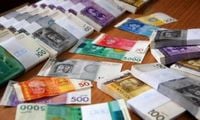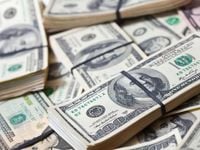On April 16, 2025, the currency markets reflected a significant shift as the American dollar continued its downward trajectory, hitting its lowest point in three years. This decline has raised concerns among investors, prompting a reevaluation of the dollar's role in the global economy. As the dollar weakens, the euro has emerged as a primary beneficiary, gaining ground and reinforcing its position as a viable alternative.
The dollar index, which measures the value of the dollar against a basket of other currencies, has fallen by more than 4% since the beginning of April. On this date, the dollar fell by 0.7%, further solidifying the trend of depreciation. President Donald Trump has maintained that the dollar will remain the world's primary currency; however, experts are cautioning that its dominance may be diminishing. Michael Brown, an analyst from Pepperstone, pointed out that the current economic climate could lead to a continued weakening of the dollar, especially in the absence of alternative currencies that could take its place.
In contrast, the euro has seen a remarkable increase, rising by 5% since what Trump has dubbed "Liberation Day." The European Central Bank has been proactive in supporting the euro as a strong alternative to the dollar, which has further fueled its rise. Meanwhile, the British pound has struggled to maintain its footing in the currency markets, although it has managed to strengthen by 2% against the dollar over the past two weeks.
As the dollar's value fluctuates, the official exchange rates in Kyrgyzstan also reflect the changing dynamics in the international currency market. On the same day, the official exchange rate of the National Bank of the Kyrgyz Republic for the US dollar was set at 87.4492 soms, showing no change. In Bishkek's exchange offices, the average buying rate was 87.31 soms, while the selling rate stood at 87.78 soms.
In contrast to the dollar, the Russian ruble and the Kazakhstani tenge experienced increases in their respective values against the som. The official exchange rate for the Russian ruble was reported at 1.0597 soms, marking a 1.27% increase. The average buying and selling rates in Bishkek were 1.041 soms and 1.078 soms, respectively. The Kazakhstani tenge also saw an increase, with an official exchange rate of 0.1692 soms, reflecting a 0.3% rise. In exchange offices, the average buying and selling rates were 0.1164 soms and 0.1914 soms.
The euro's ascent has been attributed to the ongoing decline of the dollar, with analysts noting that the eurozone's economic stability has made it an attractive option for investors seeking refuge from the dollar's volatility. In the same vein, the official exchange rate of the euro against the som was set at 99.198 soms, reflecting a decrease of 0.40%. The average buying and selling rates in Bishkek for the euro were reported at 98.38 soms and 99.38 soms.
Meanwhile, the Chinese yuan also faced a decline, with an official exchange rate of 11.9526 soms, down by 0.18%. The average buying and selling rates in exchange offices were 11.9 soms and 12.4 soms, respectively. This trend illustrates the broader challenges facing various currencies as the global economic landscape shifts.
As the dollar's influence wanes, analysts are closely monitoring the potential implications for global trade and investment. The ongoing trade tensions, particularly with China, have added another layer of complexity to the situation. Tariffs imposed by the Trump administration on Chinese goods have contributed to the pressure on the dollar, making it less appealing to investors.
Looking ahead, the fluctuations in the currency market are expected to continue, with forecasts suggesting that the dollar could hover between 83-86 rubles in the coming week, according to Maxim Timoshenko, Director of Operations at Bank Russian Standard. The euro is anticipated to trade between 95-98 rubles, reflecting the ongoing adjustments in the market.
As the world watches these developments, the question remains: how will the changing dynamics of the currency markets impact global economic stability? Investors and policymakers alike are keenly aware of the potential consequences of a weakening dollar and the rise of alternative currencies.
In conclusion, the currency markets are in a state of flux, with the dollar's decline prompting a reassessment of its role in the global economy. The rise of the euro and the resilience of the ruble and tenge highlight the shifting landscape and the need for investors to adapt to these changes.





